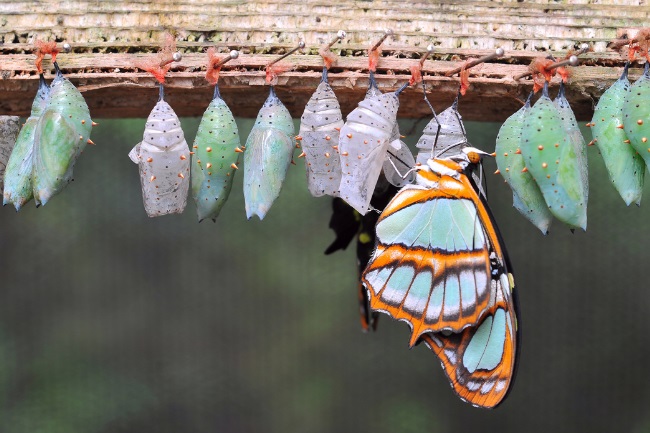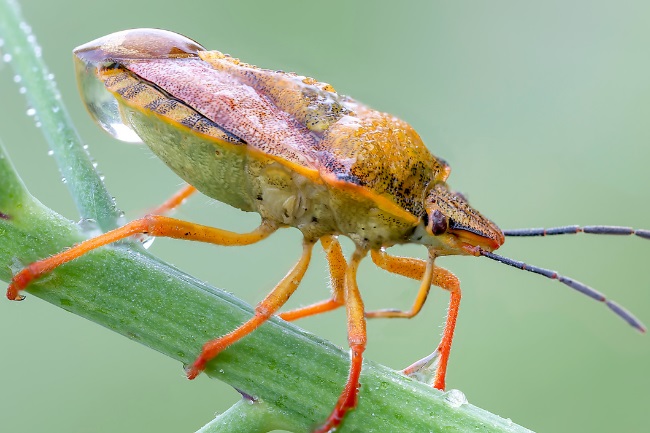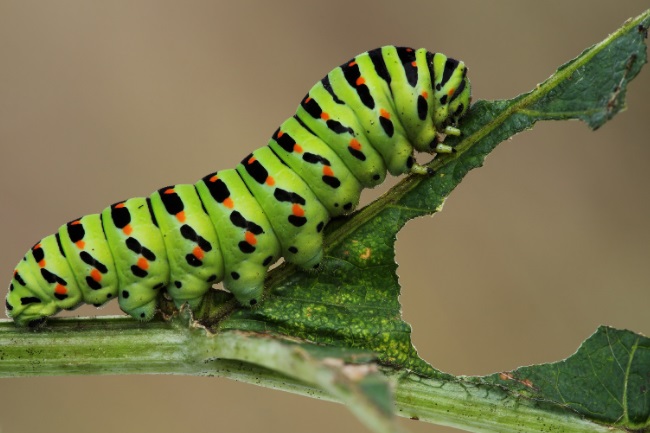Caterpillars are insects, but they are not a type of bug. They fall into the insect category because they have an exoskeleton, three sets of true legs, a set of antenna and a segmented body with three main parts.
Contents
What is an insect?
An insect is a type of arthropod, meaning an animal with a segmented body and an exoskeleton. Crustaceans such as lobsters and crabs are also arthropods, as are spiders, but none of these are insects.

What defines an animal as being in the group known as Insecta is several key characteristics. Firstly insects have three segments to their body; a head, thorax and abdomen. They also have three pairs of segmented legs and a set of antennae. They also have that vital exoskeleton that all arthropods have.
By comparison, spiders cannot be insects as they have eight legs and only two segments in their bodies, as their head and thorax have fused. Myriapods like centipedes have many more legs and segments. At the same time, molluscs like slugs and snails have no exoskeleton and no legs.
Also read: How Big Can a Garden Spider Get? (Female vs. Male)
From a caterpillar to a butterfly
We all know that a fat little caterpillar becomes a beautiful butterfly, or indeed a moth, but these stages are so different that some scientists have proposed that they are in fact separate species that have fused. Though most agree that this is not the case, it’s certainly an exciting idea.

Generally, it is the adult form that must follow our insect rules for something to be considered an insect. Most entomologists (insect scientists) agree that the juvenile stage of many insects is very different. However, it’s interesting to look at the caterpillar alongside the adult butterfly or moth to see how many of the rules it follows.
| Characteristic | Description |
|---|---|
| Three Body Segments | Caterpillars also have three main body segments: head, thorax, and abdomen. |
| Six True Legs | Caterpillars typically have six true legs near their thorax, which are used for crawling. |
| Prolegs | In addition to true legs, caterpillars have fleshy prolegs along their abdomen, providing additional support and grip. |
| No Wings | Caterpillars do not have wings during their larval stage; they develop wings during metamorphosis as they transform into adult butterflies or moths. |
| Chitinous Exoskeleton | Like all insects, caterpillars have a chitinous exoskeleton that protects their bodies. |
| Metamorphosis | Caterpillars undergo complete metamorphosis, transitioning from eggs to larvae (caterpillars) to pupae and finally to adult butterflies or moths. |
Also read: What Caterpillars turn into Monarch Butterflies? (A List)
Three segmented bodyparts
Insects have three body segments; the head, thorax and abdomen. However, these aren’t always as easy to tell apart as you’d think. Some insects, like beetles, have very prominent subsections to these bodyparts, like the pronotum, which is a part of the thorax.
Additionally, the individual parts of the abdomen and thorax can have their own segments that seem to run into one another with no clear delineation, making it look like one long piece. You really do need to be an entomologist sometimes to know where one bit starts and the other bit ends.
The key to how we break up insect’s bodies lies in what each segment does. The head contains the eyes, antennae and brain. The thorax holds all other important appendages, such as the legs and wings, if the insect has them. The abdomen then contains and reproductive organs and most of the digestive system.

In an adult butterfly, the separation of these individual parts is simple. The head is often big and round, containing large eyes and very obvious antennae, particularly in male moths. It also includes the proboscis, which is the big mouth tube they use for sucking up nectar, if they eat at all, which not all adult insects do.
The thorax and abdomen are well-differentiated on butterflies and moths, with the thorax holding the three pairs of legs, and the all-important wings, and the abdomen containing the sexual parts and digestive system.
In the caterpillar, things are much less noticeable. For a start, the antennae and eyes are much smaller. Whereas an adult butterfly or moth has a compound eye, like a fly, which is made up of lots of smaller eyes grouped together, a caterpillar has only twelve little eyes. These eyes aren’t particularly good, and one of the reasons caterpillars wave their heads around is to get a better sense of things around them.
The mouthparts on the head are also different, without the long proboscis. Instead they have biting jaws called mandibles and maxilla behind for chewing. Still, the head is generally reasonably obvious on most species, though many may have false heads or eye-spots on other parts of their body to fool predators. The gum-leaf skeletoniser caterpillar wears a tower of its own moulted heads from its various growth spurts. I guess two, or five, heads are better than one.
Caterpillars also have a thorax and abdomen, though where these stop and begin is rather for the experts to say, as it’s not easy to spot.
Also read: Here’s “Why Bee is an Insect” (Explaining the Characteristics)
An exoskeleton
In some species of insect, the exoskeletons are very obvious, such as in beetles. The exoskeleton is the hard outer skin that invertebrates have instead of the internal spine that animals such as mammals have. In butterflies, moths and caterpillars, this hard casing isn’t as easily spotted.
For a start, butterflies and moths are often hairy. These tiny hairs help to keep them warm. Moths, in particular, can sometimes be very fluffy, as can butterflies like the Scotch argus. In general, species adapted to cold conditions seem to have more fuzz. However, under this fuzz, there is an exoskeleton, protecting their bodies from the outside world. Over time even fluffy species can slowly lose their hair as it wears away with age, making the exoskeleton more obvious.
In caterpillars, their squishy bodies are rather more reminiscent of molluscs, and it’s hard to imagine they’ve got an external skeleton holding them together. Yet just like all insects, they must moult their skin to grow. Caterpillars grow a great deal during their lifecycle, sometimes increasing their body mass 1,000 times from what they were in just a few weeks.
Some caterpillars are also fuzzy. Though this fuzz can also be to keep them warm, it’s often mainly a defensive strategy. The fluff can break off and irritate the skin of a predator trying to attack them or make them unpleasant to swallow.
Also read: Are Caterpillars Poisonous? Are they Dangerous? (Explained)
Three pairs of legs
In butterflies and moths, the three-segmented legs are easy to count and see. Fascinatingly butterflies can use their feet to taste, and sometimes you might notice one stamping around on a leaf or flower as it does so.
In caterpillars, it would seem like we come a little unstuck here with the whole insect anatomy. Even a small child knows the long body of a caterpillar requires more than three sets of legs to get around. In fact, entomologists have an answer for this. The caterpillar has three sets of true legs. These are the top three sets of legs closest to the head. They are the only fully developed segmented legs on our caterpillar.

Behind this, the caterpillar has what are known as prolegs; these are almost little stumps that it can use to grab onto vegetation. The very last set are attractively called anal claspers. Most caterpillars fall into two groups. These are the more traditional caterpillars which have three true legs at the front and then four prolegs neatly arranged behind, with an anal clasper at the back. These tend to move in more of a creeping, walking motion.
Then there are loopers, or inchworms, as they are known. These have three true legs bunched up at the front and then one set of prolegs and an anal clasper at the back, leaving a significant gap in between. These move in what we tend to think of as a caterpillar style, grasping on with their front legs and then lifting their back legs forward to form a loop with their bodies, then stretching their front legs ahead again. It’s fascinating to watch.
Also read: How Many Legs does a Butterfly Have? (Different Species)
Antennae
Antennae come in pairs on insects and sit on their heads. Moths and butterflies have very obvious antennae, sometimes being very long. Male moths often have beautiful feather-like antennae. These appendages are incredibly important and help the insects pick up smells and sense other things such as heat and humidity, and even help them navigate. One key use is to pick up the pheromones of the opposite sex, and moth and butterfly surveyors sometimes use pheromone lures to bring in and trap individuals.

In caterpillars, the antennae aren’t so obvious in many species. Though some, like the swallowtail butterfly, have a prominent pair, many only have a small set. They sit just above the mouth and are used to help the caterpillar smell and taste their food, as many plants build up toxin when under insect attack this will tell the little herbivores when to stop eating and move on.
Also read: Wondering if “Millipedes have Antennae?” (Sensory Organ)
Are caterpillars a bug?

The word ‘bug’, like ‘insect’, is vastly overused. True bugs are a type of insect with a tubular mouth they use to suck up their food. Generally, they are sap suckers such as shield bugs and aphids. However, some have adapted to a carnivorous diet.
Whilst it’s evident that caterpillars don’t have these protrusions, butterflies do have their proboscis. However, these are retractable, whereas those of the true bugs aren’t. Therefore, though we may be in the habit of calling everything small that crawls a bug, we can genuinely say that caterpillars are insects but not bugs.
So what is a caterpillar?
So caterpillars are insects because of an important suite of anatomical features that they possess.
Some of them are confusing, like the fact that they have six legs when we can count sixteen or the fact that they have an external skeleton when they seem soft and squishy. Perhaps it’s easiest to remember that caterpillars turn into moths and butterflies, which are easier to think of as insects, playing by the rules of the game much more openingly.

